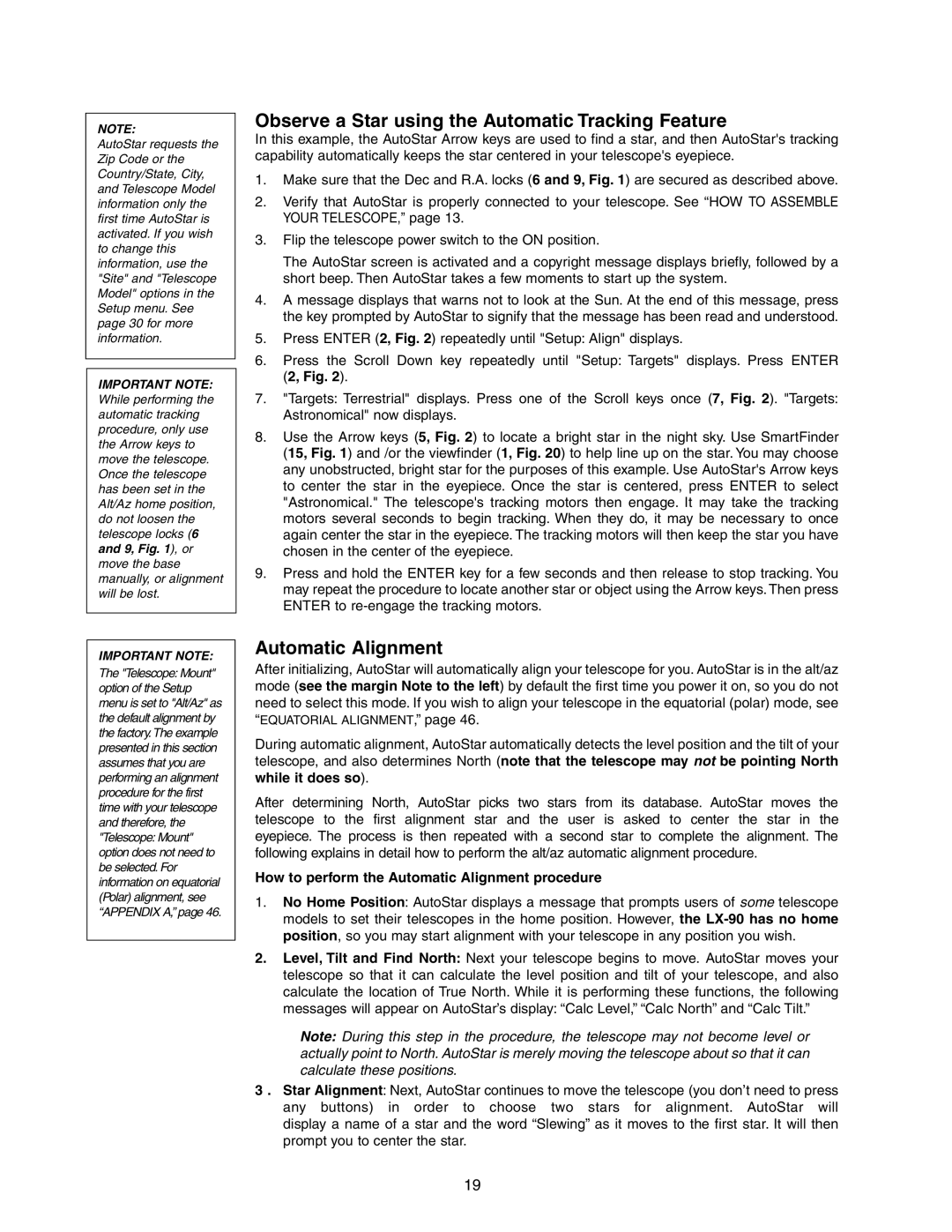
NOTE:
AutoStar requests the Zip Code or the Country/State, City, and Telescope Model information only the first time AutoStar is activated. If you wish to change this information, use the "Site" and "Telescope Model" options in the Setup menu. See page 30 for more information.
IMPORTANT NOTE:
While performing the automatic tracking procedure, only use the Arrow keys to move the telescope. Once the telescope has been set in the Alt/Az home position, do not loosen the telescope locks (6 and 9, Fig. 1), or move the base manually, or alignment will be lost.
IMPORTANT NOTE:
The "Telescope: Mount" option of the Setup menu is set to "Alt/Az" as the default alignment by the factory.The example presented in this section assumes that you are performing an alignment procedure for the first time with your telescope and therefore, the "Telescope: Mount" option does not need to be selected. For information on equatorial (Polar) alignment, see “APPENDIX A,” page 46.
Observe a Star using the Automatic Tracking Feature
In this example, the AutoStar Arrow keys are used to find a star, and then AutoStar's tracking capability automatically keeps the star centered in your telescope's eyepiece.
1.Make sure that the Dec and R.A. locks (6 and 9, Fig. 1) are secured as described above.
2.Verify that AutoStar is properly connected to your telescope. See “HOW TO ASSEMBLE YOUR TELESCOPE,” page 13.
3.Flip the telescope power switch to the ON position.
The AutoStar screen is activated and a copyright message displays briefly, followed by a short beep. Then AutoStar takes a few moments to start up the system.
4.A message displays that warns not to look at the Sun. At the end of this message, press the key prompted by AutoStar to signify that the message has been read and understood.
5.Press ENTER (2, Fig. 2) repeatedly until "Setup: Align" displays.
6.Press the Scroll Down key repeatedly until "Setup: Targets" displays. Press ENTER (2, Fig. 2).
7."Targets: Terrestrial" displays. Press one of the Scroll keys once (7, Fig. 2). "Targets: Astronomical" now displays.
8.Use the Arrow keys (5, Fig. 2) to locate a bright star in the night sky. Use SmartFinder (15, Fig. 1) and /or the viewfinder (1, Fig. 20) to help line up on the star. You may choose any unobstructed, bright star for the purposes of this example. Use AutoStar's Arrow keys to center the star in the eyepiece. Once the star is centered, press ENTER to select "Astronomical." The telescope's tracking motors then engage. It may take the tracking motors several seconds to begin tracking. When they do, it may be necessary to once again center the star in the eyepiece. The tracking motors will then keep the star you have chosen in the center of the eyepiece.
9.Press and hold the ENTER key for a few seconds and then release to stop tracking. You may repeat the procedure to locate another star or object using the Arrow keys. Then press ENTER to
Automatic Alignment
After initializing, AutoStar will automatically align your telescope for you. AutoStar is in the alt/az mode (see the margin Note to the left) by default the first time you power it on, so you do not need to select this mode. If you wish to align your telescope in the equatorial (polar) mode, see “EQUATORIAL ALIGNMENT,” page 46.
During automatic alignment, AutoStar automatically detects the level position and the tilt of your telescope, and also determines North (note that the telescope may not be pointing North
while it does so).
After determining North, AutoStar picks two stars from its database. AutoStar moves the telescope to the first alignment star and the user is asked to center the star in the eyepiece. The process is then repeated with a second star to complete the alignment. The following explains in detail how to perform the alt/az automatic alignment procedure.
How to perform the Automatic Alignment procedure
1.No Home Position: AutoStar displays a message that prompts users of some telescope models to set their telescopes in the home position. However, the
2.Level, Tilt and Find North: Next your telescope begins to move. AutoStar moves your telescope so that it can calculate the level position and tilt of your telescope, and also calculate the location of True North. While it is performing these functions, the following messages will appear on AutoStar’s display: “Calc Level,” “Calc North” and “Calc Tilt.”
Note: During this step in the procedure, the telescope may not become level or actually point to North. AutoStar is merely moving the telescope about so that it can calculate these positions.
3 . Star Alignment: Next, AutoStar continues to move the telescope (you don’t need to press any buttons) in order to choose two stars for alignment. AutoStar will display a name of a star and the word “Slewing” as it moves to the first star. It will then prompt you to center the star.
19
